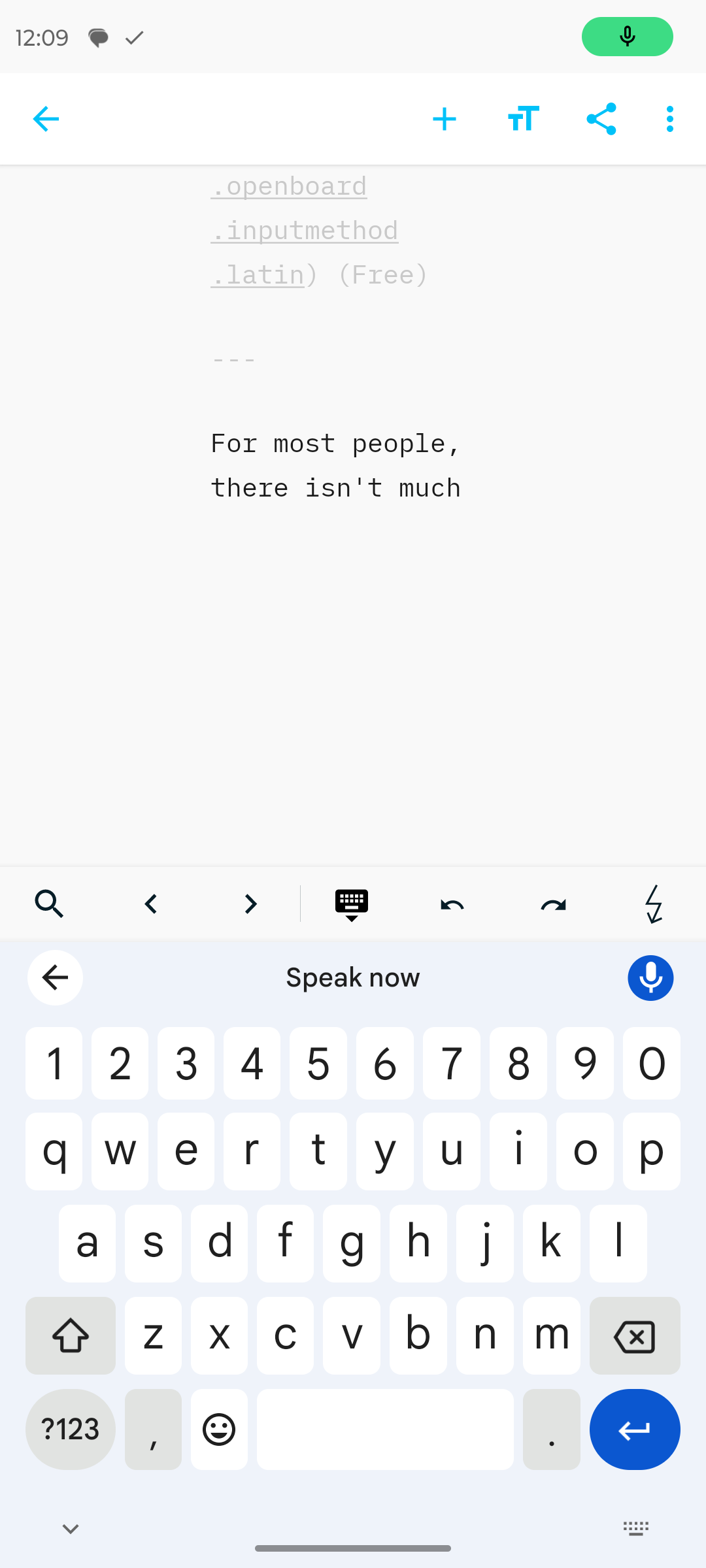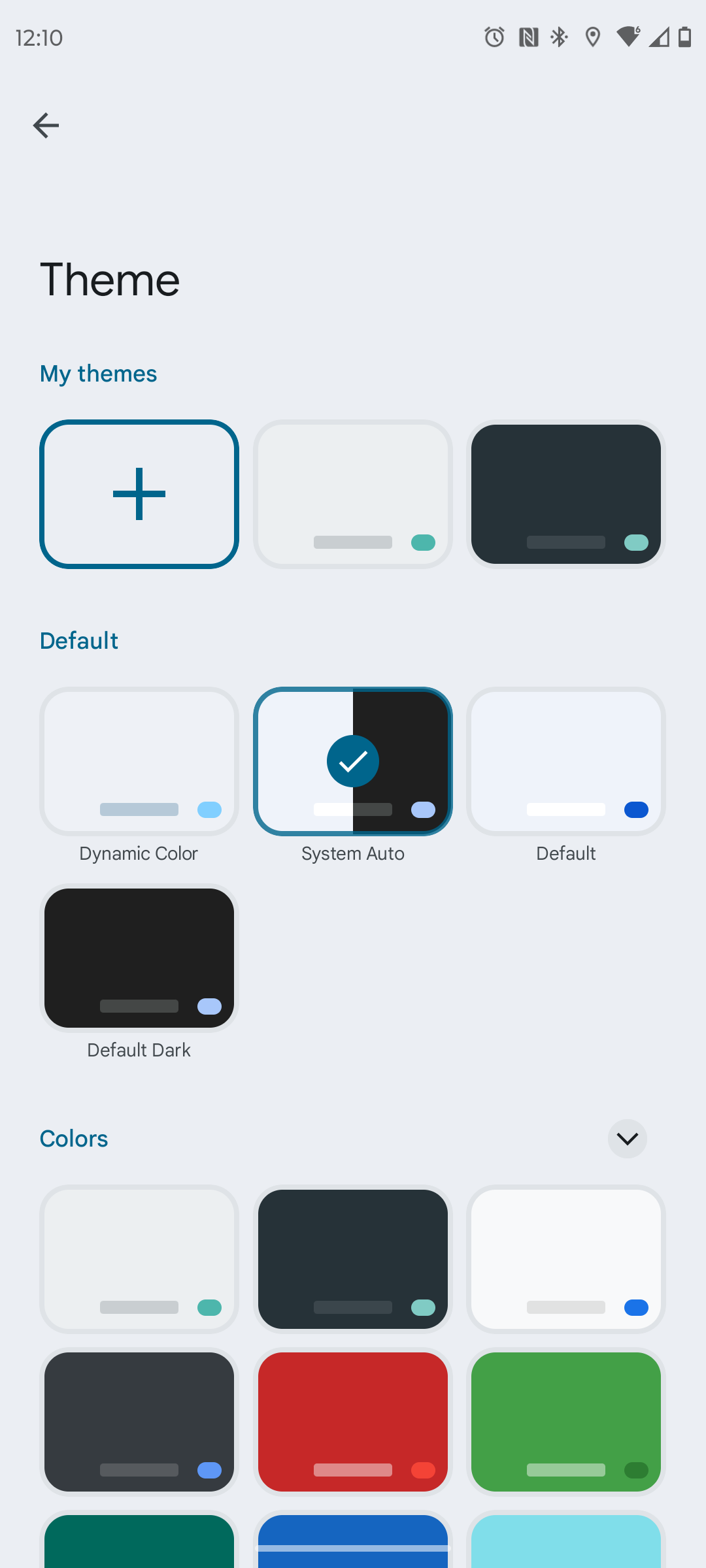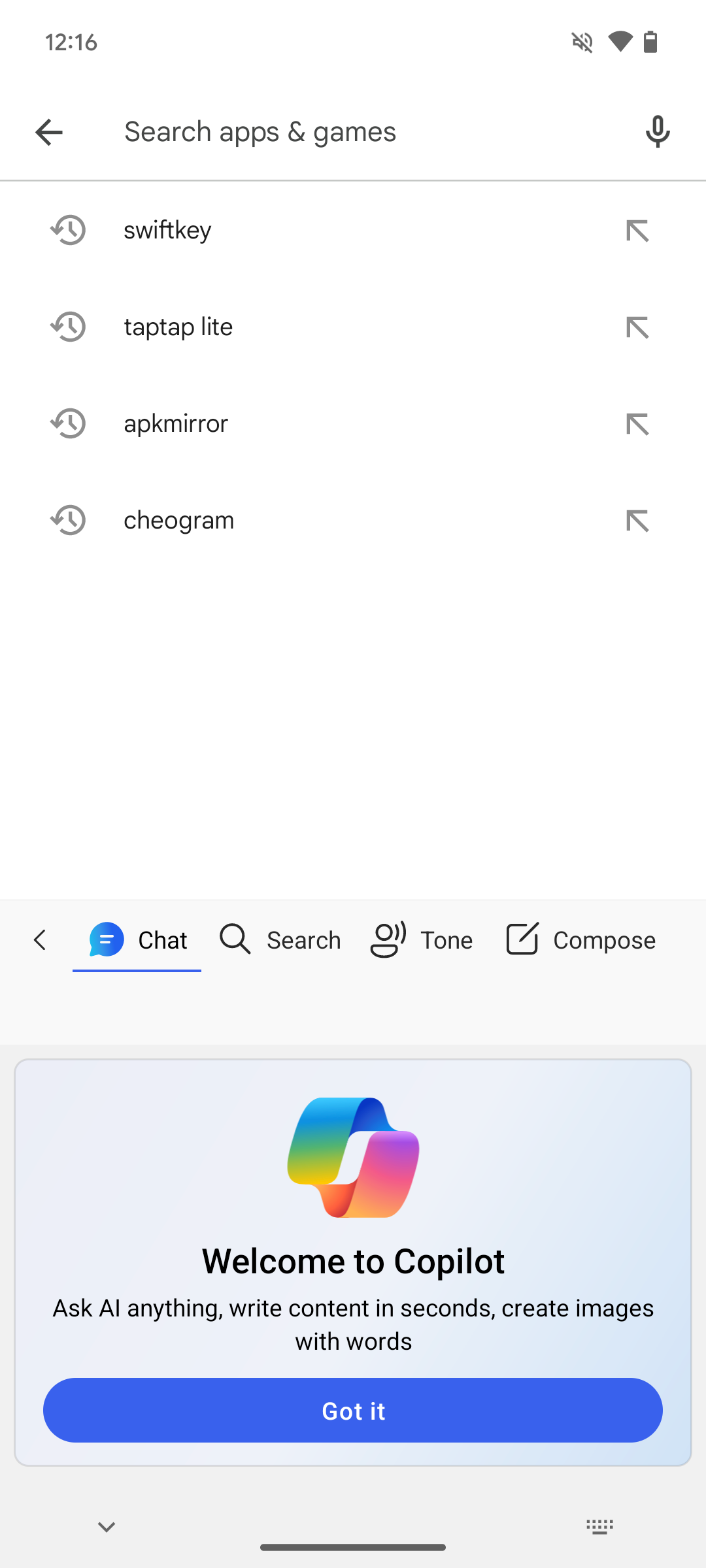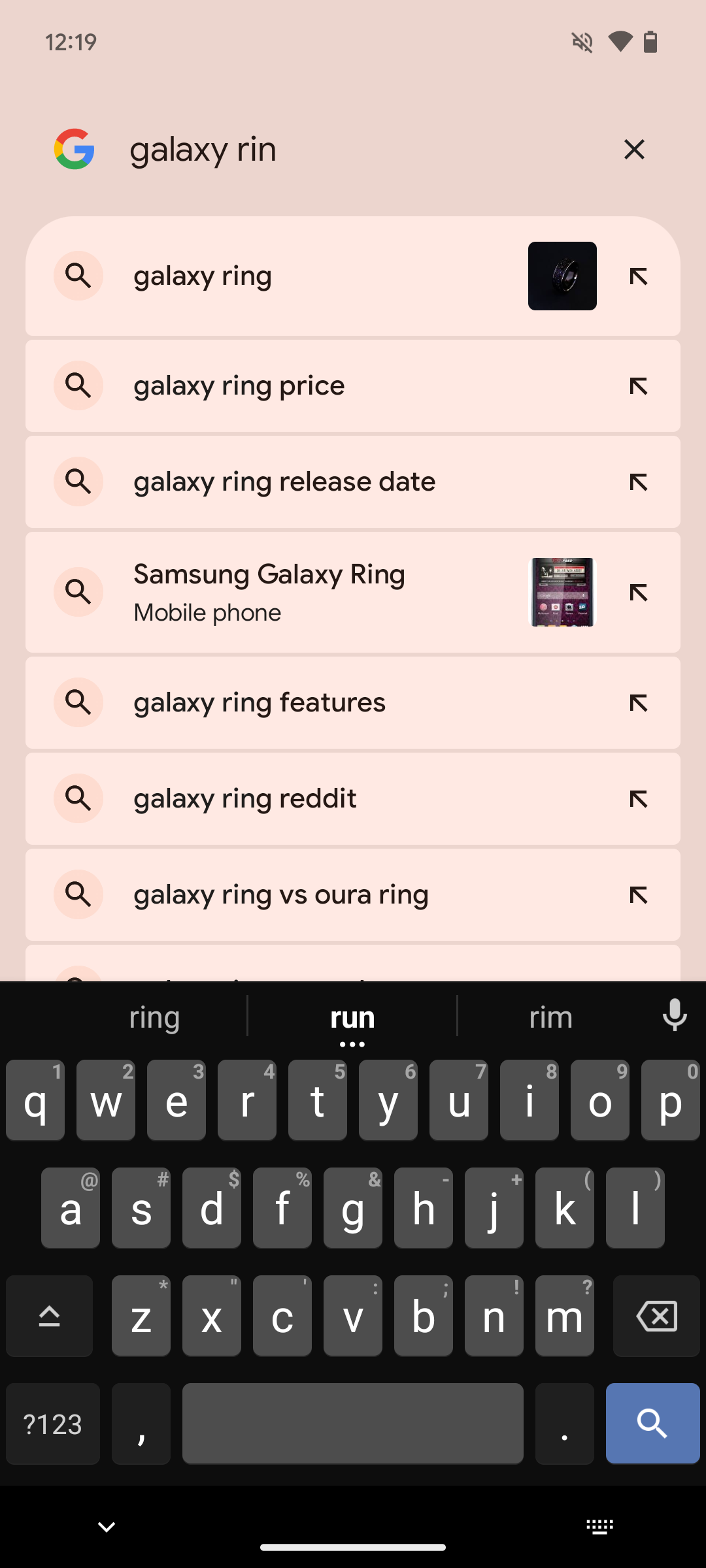Is It Still Worth Replacing the Default Android Keyboard?
Early Android phones came with keyboards that were remarkable for how much worse they were than third-party options. These days, that isn’t the case. You probably haven’t given much thought to the keyboard that pops up whenever you try to type on your phone. Do you gain anything by seeking out an alternative?
First things first: there isn’t one default Android keyboard. If you use a Pixel or one of the phones that ship with a relatively stock version of Android, then you’re using Gboard, Google’s keyboard. If you’re using a Samsung Galaxy device, you’re using the Samsung Keyboard. If your phone comes with something else, there's a good chance it's also a solid keyboard.
Keyboard Predictions Are Pretty Good Now
Google’s predictions are pretty reliable, so even if your keypresses are all over the place, you can generally count on the word you meant to type appearing above your keyboard. The experience is similar on phones that ship with Samsung Keyboard.
In the early days of Android, you needed a third-party keyboard for predictions this good. Case in point, SwiftKey amassed a large following when it launched in 2010 by guessing your next word based in part on what you've already typed in the past. These predictions improved over time as the keyboard studied your usage. Microsoft purchased SwiftKey in 2016, but by then Android manufacturers had already incorporated much of what made SwiftKey special into their own keyboards. This kind of prediction is now just part of how an Android phone works, unless you opt out.
You Don't Need a 3rd-Party Keyboard for Swipe Input

Not long after Swype first hit the scene in 2009, it was a must-have app. Here was an innovative way to type on touchscreens that eliminated the downsides of no longer having physical keys. You dragged your finger across the keys you would otherwise have tapped, and then Swype guessed which word you were trying to type.
Now that feature is baked into the likes of Gboard and Samsung Keyboard. It’s such an assumed part of how smartphones work that you don’t even need to enable it. If you drag your finger across the keys of a brand-new unboxed phone, words will likely appear.
Voice Input Is Good, Out of the Box

If you feel like neither poking nor swiping at your screen, you can just talk instead. Voice input is now a built-in part of Android. When your keyboard pops up, tap the mic and start talking. Your phone will transcribe what you’re saying into text. Sure, you may have to go back afterward and clear up the punctuation, but that’s still pretty impressive when you consider how much money people had to pay for voice transcribing software not all that long ago.
Default Keyboards Have Themes, Too

Giving your keyboard a vibrant color scheme was once reason enough to swap out the default for something else. Now defaults ship with an abundance of options. In the case of Gboard, you can pick from an assortment of colors, opt for a gradient, or go with a landscape photo. Samsung's keyboard can be themed and customized with Good Lock modules. While there are third-party keyboards that allow you to take customization even further, the defaults come with enough to satisfy most people who desire a keyboard that pops.
GIFs and Stickers Are Now Built-In

Let's not overlook what many people consider the most important aspect of a keyboard: its GIF game. Can you easily add GIFs? Can you search from within the keyboard? You used to need a dedicated Giphy app to have this kind of fun in any app, but that was around a decade ago. Stickers? Yeah, your phone's keyboard has those, too.
Defaults like Gboard and Samsung Keyboard have become as fun as they are functional. The emoji key is a world with a plethora of reactions to choose from.
Cool Features You Will Only Find In Third-Party Keyboards
At this point, most of us probably agree that typing on a touchscreen has been solved. If you grew up with smartphones, you might even be able to type faster on your phone than on a physical keyboard. Nonetheless, people continue to innovate. Third-party keyboards are still floating around the Play Store, attracting millions of downloads and trying out cool things. Here's a taste of what you can do.
Change the Shape of Your Keys

All default virtual keyboards attempt to replicate the look of the physical keyboards they replace. Yet a virtual keyboard isn’t faced with the same constraints. You can make a key any shape you want, and some of those shapes allow you to fit larger keys into the same amount of screen space. That’s why Typewise does away with square-shaped keys in favor of hexagons.
With a combination of larger touch targets and intuitive use of gestures (swipe left to delete text), you can learn to type faster with Typewise than on Gboard. The emphasis here is on “learn” since you’re going to typo quite a bit at first while your fingers adjust to the new lay of the land.
Download:Typewise (Free, premium subscription with optional features)
Integrate With Your Windows PC

Gboard syncs everything well between devices you’ve signed into with a Google account. This means Android and Chromebooks, primarily. But if you spend a lot of time on a Windows PC and you want to share a clipboard between your computer and your phone, check out Microsoft SwiftKey.
SwiftKey also utilizes Copilot, an AI you may have come across if you’re immersed in Microsoft’s ecosystem. It’s baked into the Edge browser, various Microsoft apps, and even Windows itself. If you’re all-in on Copilot, SwiftKey is a natural fit. You can even go further by replacing Google Assistant with Copilot on Android.
Download:Microsoft SwiftKey (Free)
Keep What You Type Private

Like many mobile apps, it’s hard to know whether your keyboard app is logging what you write anonymously or otherwise. Gboard is no exception here. If you want peace of mind, then your best bet is to use an option that’s open-source. For that, there’s OpenBoard.
OpenBoard probably won’t speed up your typing. It lacks swiping entirely, but you still have nice-to-haves like autocorrect, clipboard integration, theming, and the ability to add a number row.
Download:OpenBoard (Free)
For most people, there isn't much need to seek out a third-party keyboard. The defaults work. Well done. Yet it's nice to have options, and Android continues not to disappoint in that area. You can search for another keyboard for no reason other than to play around with new keyboards, and you will still find a dozen or so options in the Play Store to keep you busy.
-
 How to delete duplicate photos on Mac?Digital clutter is a common problem, especially with photos. Most people take numerous shots from similar angles, leading to a proliferation of dupli...Software tutorial Posted on 2025-05-02
How to delete duplicate photos on Mac?Digital clutter is a common problem, especially with photos. Most people take numerous shots from similar angles, leading to a proliferation of dupli...Software tutorial Posted on 2025-05-02 -
 Recommended Best Solar Chargers in 2025Whether you often camp off the grid, go backpacking, or grapple with power outages, a solar charger is a nifty gadget to have in your arsenal. It can ...Software tutorial Posted on 2025-05-02
Recommended Best Solar Chargers in 2025Whether you often camp off the grid, go backpacking, or grapple with power outages, a solar charger is a nifty gadget to have in your arsenal. It can ...Software tutorial Posted on 2025-05-02 -
 The ultimate guide to resetting your phone without losing dataRejuvenate Your Smartphone: A Guide to Factory Resets Remember that initial thrill of powering on your new phone? That pristine interface, lightning-...Software tutorial Posted on 2025-05-01
The ultimate guide to resetting your phone without losing dataRejuvenate Your Smartphone: A Guide to Factory Resets Remember that initial thrill of powering on your new phone? That pristine interface, lightning-...Software tutorial Posted on 2025-05-01 -
 7 practical tips for Apple's new version of Messages applicationiMessage's Hidden Gems: Mastering iOS 16's Enhanced Messaging Features iMessage, Apple's secure messaging platform, has evolved significan...Software tutorial Posted on 2025-05-01
7 practical tips for Apple's new version of Messages applicationiMessage's Hidden Gems: Mastering iOS 16's Enhanced Messaging Features iMessage, Apple's secure messaging platform, has evolved significan...Software tutorial Posted on 2025-05-01 -
 How to hide yourself on social platforms such as Instagram, Facebook, XMaintaining online privacy on social media is crucial, even for close friends and family. You might want to limit access to prevent unwanted attentio...Software tutorial Posted on 2025-05-01
How to hide yourself on social platforms such as Instagram, Facebook, XMaintaining online privacy on social media is crucial, even for close friends and family. You might want to limit access to prevent unwanted attentio...Software tutorial Posted on 2025-05-01 -
 A simple tutorial on how to fax files on your phoneSome organizations still don't accept documents via email—you may need to fax documents instead. No, you can't use your smartphone's phon...Software tutorial Posted on 2025-04-29
A simple tutorial on how to fax files on your phoneSome organizations still don't accept documents via email—you may need to fax documents instead. No, you can't use your smartphone's phon...Software tutorial Posted on 2025-04-29 -
 How to delete temporary Mac files? Find and clear methodsClearing Temporary Files on Your Mac: Reclaim Disk Space and Boost Performance Temporary files, often overlooked, can consume significant disk space o...Software tutorial Posted on 2025-04-29
How to delete temporary Mac files? Find and clear methodsClearing Temporary Files on Your Mac: Reclaim Disk Space and Boost Performance Temporary files, often overlooked, can consume significant disk space o...Software tutorial Posted on 2025-04-29 -
 Is the volume stuck at 100% in Windows? Try these solutionsWindows volume stuck at 100%? Easy to fix! Computer volume issues are a headache! If your Windows volume is stuck at 100%, don't worry, this Min...Software tutorial Posted on 2025-04-29
Is the volume stuck at 100% in Windows? Try these solutionsWindows volume stuck at 100%? Easy to fix! Computer volume issues are a headache! If your Windows volume is stuck at 100%, don't worry, this Min...Software tutorial Posted on 2025-04-29 -
 How to delete your data from a person search siteThis article was last updated on February 24, 2025. Many people are unaware that a significant amount of their personal data is readily accessible on...Software tutorial Posted on 2025-04-21
How to delete your data from a person search siteThis article was last updated on February 24, 2025. Many people are unaware that a significant amount of their personal data is readily accessible on...Software tutorial Posted on 2025-04-21 -
 How to disguise an iPad as a laptopThis updated article (originally published October 31, 2019) explores how to transform your iPad into a laptop alternative using iPadOS 16 beta featur...Software tutorial Posted on 2025-04-21
How to disguise an iPad as a laptopThis updated article (originally published October 31, 2019) explores how to transform your iPad into a laptop alternative using iPadOS 16 beta featur...Software tutorial Posted on 2025-04-21 -
 How to clean Mac mailbox cache? How to delete it on Mac?This guide explains how to clear the Mail cache on your Mac, addressing common issues like slow performance and email loading problems. The macOS Mai...Software tutorial Posted on 2025-04-21
How to clean Mac mailbox cache? How to delete it on Mac?This guide explains how to clear the Mail cache on your Mac, addressing common issues like slow performance and email loading problems. The macOS Mai...Software tutorial Posted on 2025-04-21 -
 How to prioritize the allocation of WiFi to the most needed devicesModern homes usually have multiple devices connected to Wi-Fi access networks simultaneously, which often leads to bandwidth tightness, especially w...Software tutorial Posted on 2025-04-19
How to prioritize the allocation of WiFi to the most needed devicesModern homes usually have multiple devices connected to Wi-Fi access networks simultaneously, which often leads to bandwidth tightness, especially w...Software tutorial Posted on 2025-04-19 -
 McAfee antivirus software review: Is it enough? 【Function, Price】McAfee: A Veteran Antivirus, But Is It the Best for Macs? McAfee, a long-standing and reputable name in cybersecurity, offers a robust antivirus suite...Software tutorial Posted on 2025-04-19
McAfee antivirus software review: Is it enough? 【Function, Price】McAfee: A Veteran Antivirus, But Is It the Best for Macs? McAfee, a long-standing and reputable name in cybersecurity, offers a robust antivirus suite...Software tutorial Posted on 2025-04-19 -
 OnePlus Watch 3 is postponed to April due to funny issuesAfter the long-awaited OnePlus Watch 3 smartwatch is released, the purchase plan may require a slight adjustment. A ridiculous production problem has...Software tutorial Posted on 2025-04-19
OnePlus Watch 3 is postponed to April due to funny issuesAfter the long-awaited OnePlus Watch 3 smartwatch is released, the purchase plan may require a slight adjustment. A ridiculous production problem has...Software tutorial Posted on 2025-04-19 -
 Tips to make the most of the tap function on the back of your iPhoneOver the years, Apple has developed a large number of tools to make using iPhones more convenient. Although the "Tap Back" feature is dull,...Software tutorial Posted on 2025-04-18
Tips to make the most of the tap function on the back of your iPhoneOver the years, Apple has developed a large number of tools to make using iPhones more convenient. Although the "Tap Back" feature is dull,...Software tutorial Posted on 2025-04-18
Study Chinese
- 1 How do you say "walk" in Chinese? 走路 Chinese pronunciation, 走路 Chinese learning
- 2 How do you say "take a plane" in Chinese? 坐飞机 Chinese pronunciation, 坐飞机 Chinese learning
- 3 How do you say "take a train" in Chinese? 坐火车 Chinese pronunciation, 坐火车 Chinese learning
- 4 How do you say "take a bus" in Chinese? 坐车 Chinese pronunciation, 坐车 Chinese learning
- 5 How to say drive in Chinese? 开车 Chinese pronunciation, 开车 Chinese learning
- 6 How do you say swimming in Chinese? 游泳 Chinese pronunciation, 游泳 Chinese learning
- 7 How do you say ride a bicycle in Chinese? 骑自行车 Chinese pronunciation, 骑自行车 Chinese learning
- 8 How do you say hello in Chinese? 你好Chinese pronunciation, 你好Chinese learning
- 9 How do you say thank you in Chinese? 谢谢Chinese pronunciation, 谢谢Chinese learning
- 10 How to say goodbye in Chinese? 再见Chinese pronunciation, 再见Chinese learning

























